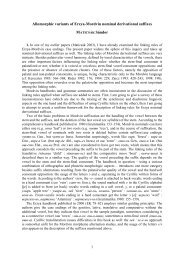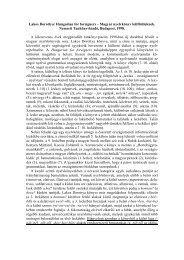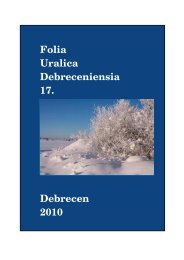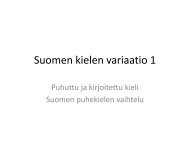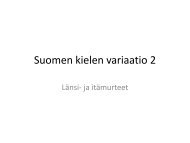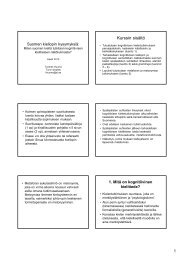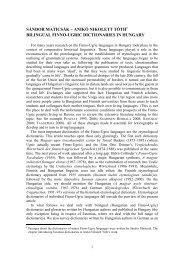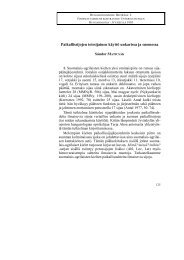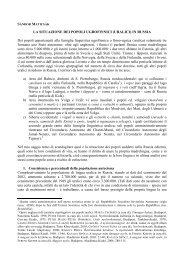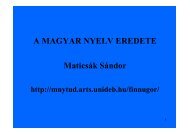folia uralica debreceniensia 19. - Finnugor Nyelvtudományi Tanszék
folia uralica debreceniensia 19. - Finnugor Nyelvtudományi Tanszék
folia uralica debreceniensia 19. - Finnugor Nyelvtudományi Tanszék
You also want an ePaper? Increase the reach of your titles
YUMPU automatically turns print PDFs into web optimized ePapers that Google loves.
A HÁTRAVETETT HATÁROZÓ KIALAKULÁSÁRÓL<br />
VNyj. = Munkácsi Bernát: A vogul nyelvjárások szóragozásukban ismertetve.<br />
Magyar Tudományos Akadémia, Budapest, 1894.<br />
Wiedemann, Ferdinand Johann 2005: Grammatik der estnischen Sprache,<br />
Durchgesehene Faksimile der Ausgabe von 1875. Herausgegeben von<br />
Karl Pajusalu und Urmas Sutrop. Stiftung für Estnische Sprache, Tallinn.<br />
WV 6 = Kannisto, Artturi–Liimola, Matti: Wogulische Volksdichtung gesammelt<br />
und übersetzt von A. K. bearbeitet und herausgegeben von M. L.<br />
VI. Band, Schisksalslieder, Klagelieder, Kinderreime, Rätsel, Verschiedenes.<br />
Mémoires de la Société Finno-ougrienne 134. Suomalais-ugrilainen<br />
Seura, Helsinki, 1963.<br />
*<br />
Reflections on the origin and development<br />
of adverbial complements in postposition<br />
The aim of this paper is to describe the origin, the grammatical categorization<br />
and the use of (the so called) adverbial complements in postposition<br />
(with attributive function). The original structure is reconstructed as Pestre<br />
való utazás ’travelling to Pest’ (literally: ’to Pest being journey’), which presumably<br />
belongs to the innovations of the Proto-Ugric language. The structure<br />
Pestre utazás (literally: ’to Pest journey’), which is almost equal to the<br />
previous structure (only the participle is missing), has been developed later.<br />
Even though the structure including the present participle form of van or lesz<br />
’to be’ can only be found in the Ugric languages, other Finno-Ugrian languages<br />
also have the same structure with participles formed from other verbs.<br />
Obviously, the adverbial complement as a preposition (in attributive function)<br />
is in connection with the original SOV word order of the Finno-Ugrian<br />
languages, which implies the fact that the attribute goes before the nouns.<br />
The appearance of adverbial complements as postpositions in the Finno-Ugrian<br />
languages (utazás Pestre) is due to the long and intensive connection<br />
with the neighbouring SVO word order Indo-European languages.<br />
László HONTI – Márta H. VARGA<br />
57



